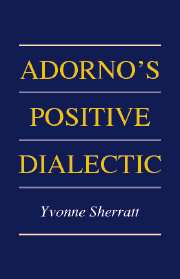Book contents
- Frontmatter
- Contents
- Preface
- Abbreviations
- Adorno's Positive Dialectic
- General Introduction
- PRELUDE TO ADORNO'S POSITIVE DIALECTIC
- Prelude I: Adorno's Intellectual Tradition: German Philosophy
- Prelude II: Adorno's Intellectual Tradition: Sigmund Freud
- ADORNO'S POSITIVE DIALECTIC: INTRODUCTION
- PART I NEGATIVE THESIS: THE DECLINE OF ENLIGHTENMENT
- PART II POSITIVE THESIS: THE REDEMPTION OF ENLIGHTENMENT
- 5 The Aesthetic: Aura
- 6 Knowledge Acquisition: An Aesthetic Form
- 7 A Positive Dialectic of Knowledge Acquisition
- 8 A Positive Dialectic of Subjectivity: The Instincts
- 9 A Positive Dialectic of Subjectivity: The Structure of The Self
- Concluding Comments
- Bibliography
- Index
5 - The Aesthetic: Aura
Published online by Cambridge University Press: 10 August 2009
- Frontmatter
- Contents
- Preface
- Abbreviations
- Adorno's Positive Dialectic
- General Introduction
- PRELUDE TO ADORNO'S POSITIVE DIALECTIC
- Prelude I: Adorno's Intellectual Tradition: German Philosophy
- Prelude II: Adorno's Intellectual Tradition: Sigmund Freud
- ADORNO'S POSITIVE DIALECTIC: INTRODUCTION
- PART I NEGATIVE THESIS: THE DECLINE OF ENLIGHTENMENT
- PART II POSITIVE THESIS: THE REDEMPTION OF ENLIGHTENMENT
- 5 The Aesthetic: Aura
- 6 Knowledge Acquisition: An Aesthetic Form
- 7 A Positive Dialectic of Knowledge Acquisition
- 8 A Positive Dialectic of Subjectivity: The Instincts
- 9 A Positive Dialectic of Subjectivity: The Structure of The Self
- Concluding Comments
- Bibliography
- Index
Summary
INTRODUCTION
Within the realm of the aesthetic we will focus upon a strand of thought which has been marginalised to Adorno's aesthetic thesis about ‘the New’. However, as will become clear, this strand in fact informs a major part of Adorno's aesthetics and, indeed, is the very basis for a positive interpretation of his philosophy as a whole.
At the centre of this strand which we wish to extricate is the aesthetic concept of aura. Aura is a concept that Adorno takes from Walter Benjamin. It is defined by three principal features which are as follows. First, it is an appearance of distance however close an object might be. Second, it points beyond the giveness of an image. Third, aura induces proximity through distance. My aim is to explain these three properties of aura and to show their relationship to each other. In so doing I will build, from the notion of aura, a foundation in aesthetic terms for a notion of a second, alternative form of knowledge acquisition. Distinct from that of the enlightenment, this will be an aesthetic form of knowledge acquisition.
The outline of this chapter is as follows. First, we will look briefly at Adorno's general concept of the aesthetic. Second, we will depict aura by utilising some of the influences behind Adorno's own analysis, such as Benjamin: we will look at aura through Benjamin's depiction of it as an historically emergent category.
- Type
- Chapter
- Information
- Adorno's Positive Dialectic , pp. 151 - 168Publisher: Cambridge University PressPrint publication year: 2002



